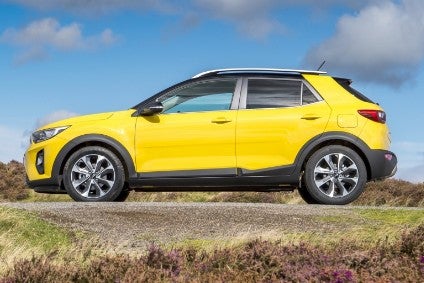 The ASEAN vehicle market expanded by over 12% in 2003 to more than 1.51m vehicles, driven by moderate to strong growth in all but one market – Malaysia. The region overcame significant difficulties last year, including the SARS outbreak, the threat of terrorist activity and – with the exception of China – generally weak export markets. Strong domestic consumption was the main driving force behind growth, as Tony Pugliese reports.
The ASEAN vehicle market expanded by over 12% in 2003 to more than 1.51m vehicles, driven by moderate to strong growth in all but one market – Malaysia. The region overcame significant difficulties last year, including the SARS outbreak, the threat of terrorist activity and – with the exception of China – generally weak export markets. Strong domestic consumption was the main driving force behind growth, as Tony Pugliese reports.
Low interest rates drive regional demand in 2003
The strong growth picture across all the region’s economies last year was underpinned by rising consumer confidence, rising stock markets and falling interest rates. Consumers have benefited from increasingly easy access to financing; but while household debt has been increasing, overall it is not regarded as a significant threat to further growth at present. Toyota and Honda, which launched the Vios and new City models across the region respectively from the end of 2002, gained most from the buoyant regional demand.
Thailand was by far the largest market last year, rising to close to pre-Asia crisis levels with unexpectedly strong volume growth of 30%. The economy grew by 6.4% – a level more reminiscent of the mid-1990s boom years. Singapore was the worst hit by the SARS epidemic, at a time when it was still struggling from the global crash in IT equipment markets. GDP growth was 0.8% last year, but vehicle market seldom reflects the strength or weakness in the real economy. Despite only moderate economic expansion in Indonesia, its consumers were drawn in by attractive packages – including cash-back programmes.
 |
click the table for an enlarged view |
Growth to continue in 2004
In 2004, regional growth is expected to moderate compared with 2003, to around 5%, as short-term demand becomes more saturated in key markets. Presidential elections will be held in the Philippines and Indonesia, creating additional uncertainty on the one hand and additional liquidity in the economy and additional vehicle purchasing activity directly. The recent outbreak of bird flu has compounded any unease that may exist, but at present it is regarded as a short-term problem that will have only a minor impact on economic growth.
Malaysian buyers are expected to return to the market after waiting in vain for better buying conditions resulting from tax cuts. Last year’s fall in volumes was mostly incurred by Proton, and the country’s first national car company is looking for some sort of bounce back this year. In Indonesia, there is some very significant new model activity that will drive demand over the next two years, despite political uncertainty and a lacklustre economy. Despite its difficulties, the country has secured a number of regional vehicle projects that are set to emerge this year.
How well do you really know your competitors?
Access the most comprehensive Company Profiles on the market, powered by GlobalData. Save hours of research. Gain competitive edge.

Thank you!
Your download email will arrive shortly
Not ready to buy yet? Download a free sample
We are confident about the unique quality of our Company Profiles. However, we want you to make the most beneficial decision for your business, so we offer a free sample that you can download by submitting the below form
By GlobalDataThailand develops momentum
Thailand’s economy has picked up considerable momentum over the last twelve months. GDP growth is estimated to have been as high as 6.4% in 2003, with the export sector performing much stronger than had been expected and with low interest rates helping to drive domestic consumption. As one of the most politically stable countries in the ASEAN trade block, Thailand has become the first choice location for ASEAN-bound FDI. Domestic business confidence has improved significantly in the last six months and domestic investment is now on the rise.
The economy this year is widely expected to perform at least on a par with last year. The Thai government is among the most bullish about the short-term outlook – predicting GDP growth of at least 8% in 2004. Growth in the domestic economy is broadening and a supplementary budget was recently approved for the current year – providing additional stimulus for growth. This is the last full year before the general election in 2005 and securing strong economic growth this year has become a priority for the Thaksin government.
Exports will be key in achieving current growth targets and the government has been very active in expanding export opportunities through bilateral free trade agreements and in attracting FDI. The construction sector, which collapsed during the 1997 economic crisis, is now also in recovery phase. Voices of caution are beginning to be heard, however – inflation has been rising in the last few months and the interest rate cycle appears to have turned. The stock market is at a historic high and property speculation is back. But few see any of these negative factors as affecting economic growth this year, particularly in view of the baht’s strength against the US dollar.
The automotive industry has transformed itself into a very substantial business with an increasingly global reach. Domestic demand is also quickly returning to pre- Asia crisis levels, after sales growth of 30% last year – way above expectations. The Bangkok motor show held in November provided an additional lift to year-end volumes, with December sales hitting a record high of almost 65,000 units.
New models such as the Toyota Vios and Honda City helped drive passenger car demand and helped the two companies gain substantial market share. Demand for pickups, which makes up around 60% of the vehicle market, has also been strong. Toyota will launch a new pickup model later this year and the Isuzu model will get a new diesel engine. This should fuel additional interest in this segment. Overall, domestic sales are expected to grow by just under 10% this year and by around 5% in 2005.
Finance packages boost Indonesia’s vehicle market
Indonesia’s GDP is estimated to have expanded by a moderate 3.9% in 2003 – largely unchanged from previous years and driven primarily by domestic consumption. Consumer demand has been particularly strong and has helped to offset continued weakness in direct investment and government expenditure. The exports sector is struggling to compete with other low-cost countries in Asia. Interest rates have fallen dramatically over the last 12 months, to below 8% from more than 13% a year earlier. Inflation remains benign, at 4%, helped by the strong rupiah:dollar rate and smaller tax increases on utilities and fuel last year. There will be little or no pressure for interest rates increases in the short tem.
Foreign direct investment has been in decline over the last few years, due mainly to the unstable political and legislative environment, although the explosive growth of China’s economy recently has also changed the investment priorities of many foreign multinational companies. But Indonesia has lost out as an investment location to Thailand. The country’s heavy foreign debt burden has reduced the scope for government expenditure to stimulate higher levels of growth.
The vehicle market performed strongly last year, particularly in view of the lacklustre performance of the broader economy. It has been spurred on by increasingly attractive finance packages, cash-back programmes and discounting. Despite strong consumer spending and credit growth, household debt is regarded as among the lowest in Asia – at 10% of GDP, and as such it is seen as having some way further to go.
The country’s first direct presidential elections will be held later this year, providing further scope for hesitancy among long-term investors. Election budgets, however, will provide additional short-term liquidity to the economy and will also directly generate additional vehicle sales. Interest rates continue to fall and this will help the vehicle market.
But most of all, new model launches will help drive sales forward this year. Volumes are expected to rise by around 5-7% this year, provided that instability does not result from the election process. Toyota and Daihatsu launched jointly made small utility vehicles in January which cost between $7,500 and $10,000. Orders for the Toyota version, the Avanza, are currently at around 20,000 and the waiting list extends until November. A total of 60,000 units of both brands are expected to be sold this year. A new low-cost passenger vehicle will be launched by Suzuki in August and the Toyota Kijang – which is by far the country’s best-selling vehicle model – will be replaced in August as well. Market strength is expected to spill over into 2005, driven by the availability of new models and potentially by stronger economic growth.
Malaysia’s consumers hold back
Malaysia’s economy grew by 4.6% in 2003, with domestic consumption and consumer confidence rising as the year progressed and as interest rates continued to decline. The export sector was supported by growing demand from China – particularly for raw materials – and this is expected to remain a key source of export growth in the short term. Demand from other overseas markets is also starting to pick up, but so is competition from low-cost countries such as China.
For this year, the government is expecting economic growth of at least 5.5%, on the back of expected higher exports, stronger domestic demand and improving investor confidence. The government has vowed to become less involved in the private sector, including the automotive industry, and this should help attract greater levels of FDI in the coming years.
The vehicle market itself declined by almost 7% last year, mainly as consumers held back purchases in anticipation of lower prices from expected import tax cuts in January 2004. This did not happen, mainly because import tax reductions were more than cancelled out by hikes in excise taxes. Greater price deregulation during the year helped the non-national car companies, particularly Toyota and Honda with their Vios and City models respectively. But this came at the expense primarily of Proton, which saw its market share drop from around 60% to below 50% last year. The commercial and utility vehicle segments also performed strongly in 2003.
The market this year is expected to see many of the buyers who were waiting on better prices to come to the market this year. This, better choice and improving economic conditions are expected to drive the vehicle market up by 6% to around 429,000 units. New model activity is unlikely to intensify until 2005, when a number of important models will be replaced or made available for the first time and this will help drive the market further forward.
Philippines’ market gets entry-level product lift
The Philippine economy grew by an estimated 4.5% in 2003, driven primarily by a strong performance from the service sector – which expanded by 5.9%. Consumer demand, particularly for transportation and communications products, was especially strong and remittances from overseas workers were also significantly higher last year. This more than made up for weaker growth in manufacturing and agricultural output, weak exports and low government expenditure. Public spending on construction and infrastructure declined by almost 18%.
After 4.4% growth in 2002, Philippines is enjoying its strongest sequential growth since the Asian economic crisis in 1997-98. Low interest rates and benign inflation (at 3.15% in 2003) – despite continued weakness in the peso against all major currencies – have helped bolster consumer demand. Substantial overcapacity in most of the country’s main industrial sectors helped the keep prices in check.
For the current year similar growth – of around 4.5% – is widely anticipated, helped by continued strength in domestic consumption and boosted by expenditure relating to the May 2004 general election. The government’s forecasts of 5.0-5.8% GDP growth expectation for this year does appear somewhat overdone, however, given the economy’s current reliance on the domestic consumer. Government expenditure will remain limited by high debt and inadequate tax receipts, so scope for stimulus spending outside the election budget is negligible. Competition in export markets has strengthened in the last few years and stronger levels of economic growth overall cannot be taken as granted.
Last year, vehicle sales grew by 7.9% and this helped support GDP growth overall. The launch of entry-level car models such as the Toyota Vios and the Honda City also helped drive volumes higher. Further market growth is expected this year – with volumes set to rise by more than 7%. Demand will be boosted by purchases of utility vehicles for political campaigning and continued strong demand for other low-cost vehicles. After several years of depressed sales, underlying replacement demand is high at present. Low interest rates and rising optimism generally will help sales.
A change in excise taxation to a system favouring lower prices will help low-end buying, but new product initiatives are unlikely to be significant this year. A face-lifted Mitsubishi Adventure is expected to do well, but new compact and full-sized utility vehicles from Toyota and a new Suzuki utility vehicle are unlikely to make it to market until 2005.
Vietnam’s vehicle market was best ever in ’03
Vietnam’s economy last year is estimated to have expanded by the fastest rate since the 1997-98 regional financial crisis, with GDP growth at 7.3%. Manufacturing output and construction, which account for over two-thirds of the economy, underpinned the robust economic performance. A combination of strong growth in exports and robust domestic consumption helped drive the economy forward. The service sector performed poorly, mainly because of much-needed reductions in utility prices such as telephone charges.
The export sector is expected to continue to drive the economy this year, although strong levels of foreign direct investment will be needed to match last year’s expansion rate. But there are a number of large projects in the pipeline, including automotive sector investment and there is a potential for large oil and gas projects (such as investment in a refinery) to be signed off in the coming years as the vehicle parc expands.
The vehicle market itself has had its best year ever, with sales of new vehicles – including imports – rising by an estimated 33% to around 43,000 units. The new vehicle market enjoyed very strong growth since restrictions were applied to imports of used light passenger vehicles, with the domestic assembly industry has benefited in particular.
A significant proportion of last year’s strong growth is understood to have come from new vehicle sales brought forward from 2004, in anticipation of a sharp rise in taxes on imports of CBU and CKD vehicles. This did materialise in January 2004 and new vehicle prices since have increased by between 20-30%. Vietnam’s cars were already among the most expensive in the world – generally about double the price for equivalent models in the West. The new taxes are expected to have a significant effect on new vehicle sales, with sales likely to drop by at least 30-40% this year if the current tax levels are maintained.






